Golden Pheasant: Know Everything about this stunning visual delight
Forget everything you think you know about birds. Indeed, the Golden Pheasant isn’t just a feathered friend; it’s a walking explosion of sunshine. Picture a phoenix reborn in a forest, its head crowned with a halo of molten gold. As you observe, the fire seems to flicker on its back while its chest glows with the embers of a dying sunset. But that’s not all! Additionally, this living masterpiece can unfurl a mesmerizing cape of orange and black feathers around its neck, transforming into a mythical creature straight out of a forgotten legend.
Furthermore, there’s more to this wonder than meets the eye. Its long, flowing tail trails behind like a regal train, adding a touch of elegance to its fiery display. In contrast, unlike its dazzling partner, the female Golden Pheasant is a mysterious creature. Draped in a cloak of mottled brown, she moves with quiet grace, her bright yellow eyes and beak the only splashes of color in her earthy tones. Together, they form a living testament to the beauty of vibrant passion and serene wisdom.
To truly appreciate these magnificent birds, explore the vibrant world of the Golden Pheasant (Chrysolophus pictus), a bird celebrated for its breathtaking plumage and captivating presence. This comprehensive blog post delves into every aspect of this magnificent species, from its habitat and physical characteristics to its behavior, breeding habits, conservation status, and lesser-known facts.
Quick info table about the Golden Pheasant:
| Aspect | Details |
|---|---|
| Scientific Name | Chrysolophus pictus |
| Native Habitat | Mountainous forests of central China |
| Physical Characteristics | Males: Vibrant golden crest, red and gold plumage; Females: Brown with barring |
| Diet | Omnivorous; seeds, fruits, insects, invertebrates |
| Behavior | Ground-dwelling, shy, crepuscular |
| Breeding | May to July; clutches of 8-12 eggs, incubated for 25-28 days |
| Conservation Status | Least Concern (IUCN); threats include habitat loss and overhunting |
| Interesting Facts | Seasonal plumage changes, cultural significance in Chinese folklore |
Habitat and Distribution
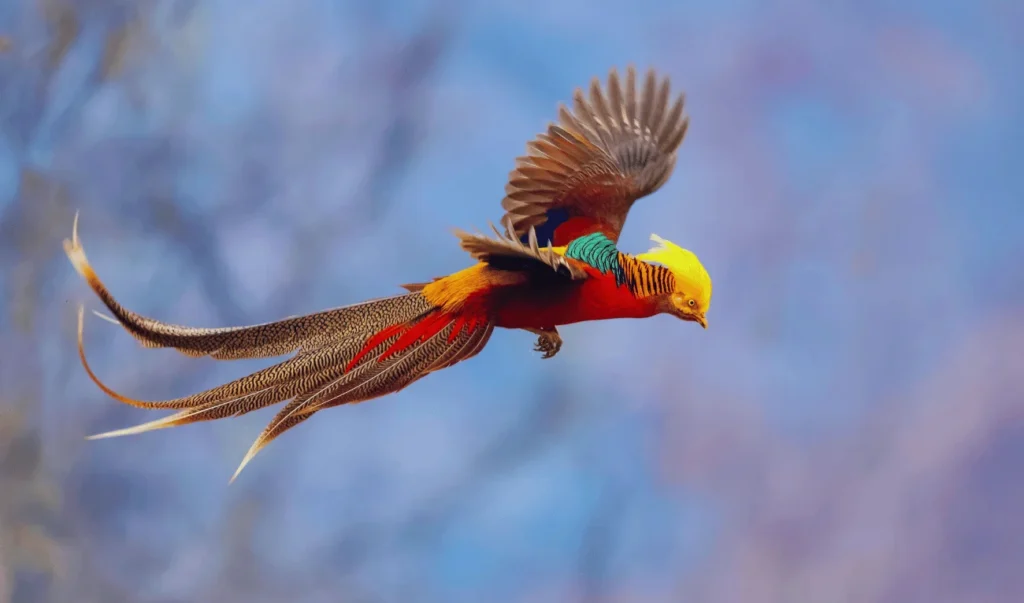
The Golden Pheasant is native to the mountainous forests of central China, predominantly found in regions such as Sichuan, Gansu, and Shaanxi provinces. Specifically, these areas boast dense undergrowth and mixed conifer and broadleaf forests, providing the ideal environment for the pheasant’s shelter and food sources.
Furthermore, while primarily found in its native habitat, the species has also been introduced to Europe and North America. However, these populations are primarily restricted to captivity or localized areas. Unfortunately, the species faces significant threats from habitat loss due to deforestation and logging, which pose severe risks to its survival in the wild.
In addition to these challenges, conservation efforts are crucial to ensure the continued existence of the Golden Pheasant in its natural habitat.
Moreover, public awareness and sustainable forestry practices can significantly contribute to mitigating the risks faced by this remarkable bird. Consequently, preserving the Golden Pheasant not only protects a unique species but also maintains the ecological balance of its native forests.
Physical Characteristics
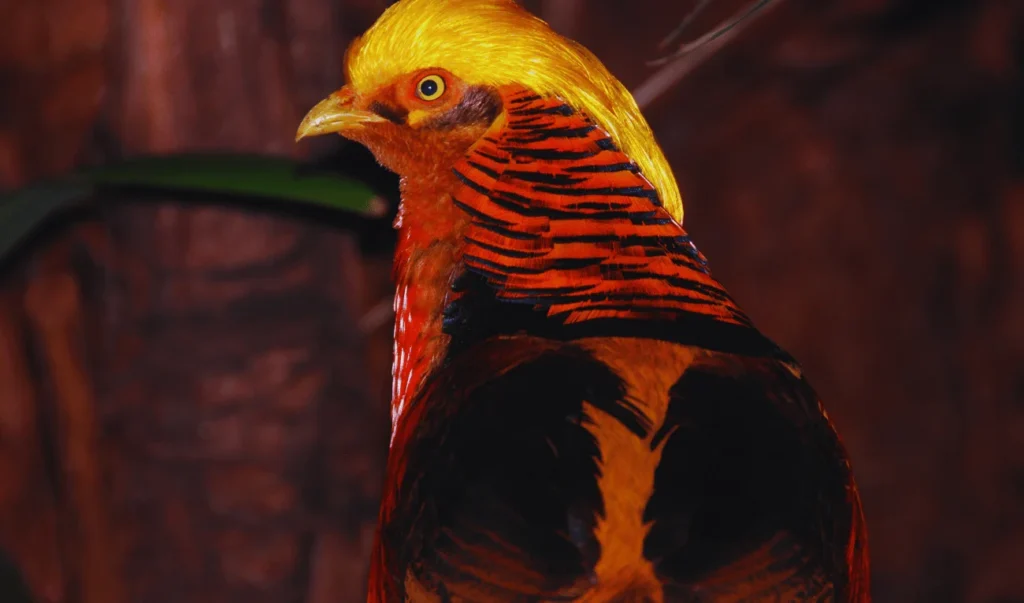
One of the most striking features of the Golden Pheasant is its vibrant plumage, particularly prominent in males:
Males
- Crest: A vivid golden yellow crest adorns the head, a defining characteristic and namesake of the species.
- Plumage: The back and rump exhibit rich golden yellow feathers, contrasting dramatically with a fiery red breast and scarlet flanks. The upper back and wings are characterized by black feathers, further accentuating its colorful and intricate pattern.
- Tail Feathers: Long and flowing, the tail feathers start with a black base and transition to cinnamon buff tips.
- Facial Features: The face features a rusty tan throat and chin, complemented by yellow wattles and orbital skin.
Females
While less flamboyant than males, females possess their own subtle beauty:
- Feathers: Cloaked in browns with intricate barring patterns, their plumage provides excellent camouflage within their natural environment.
- Legs and Feet: Notably pinkish in hue, distinguishing them from other pheasant species.
Diet and Behavior
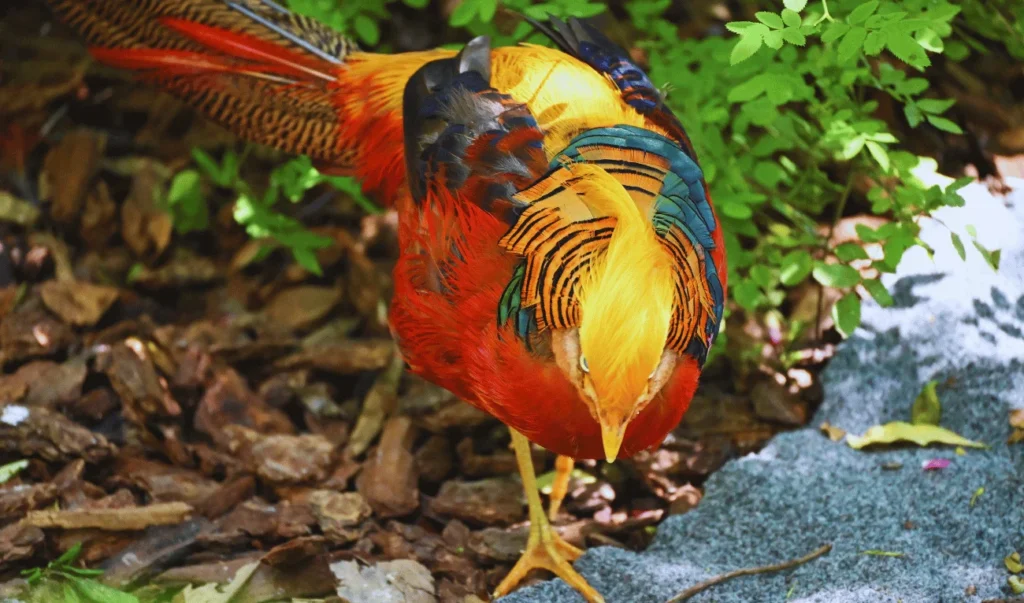
Golden Pheasants are predominantly ground-dwelling birds, spending much of their time foraging on the forest floor. Their diet is omnivorous, encompassing a variety of seeds, fruits, insects, and other invertebrates throughout the year.
Foraging and Feeding
- Seeds and Fruits: These constitute a significant portion of their diet, readily available in their forested habitats.
- Insects and Invertebrates: Vital sources of protein, especially crucial during the breeding seasons when energy demands are higher.
Behavior
Known for their shy and elusive nature, Golden Pheasants prefer to avoid open areas and human contact. They rely heavily on their exceptional camouflage abilities to blend seamlessly into the forest undergrowth, minimizing their exposure to potential predators.
During the breeding season, males engage in elaborate courtship displays, showcasing their vibrant plumage and employing various vocalizations to attract females—a spectacle vital for successful reproduction.
Breeding and Lifespan

Breeding among Golden Pheasants typically occurs between May and July. Specifically, during this period, females construct nests and lay clutches of 8-12 eggs, which they diligently incubate for approximately 25-28 days. Moreover, once hatched, the chicks—precocial from birth—are capable of leaving the nest and following their mother to forage for food immediately.
Additionally, in the wild, Golden Pheasants have an average lifespan of 10-12 years. However, this can extend significantly in captivity, where they are protected from natural predators and provided with consistent food sources. Consequently, the controlled environments contribute to their longevity and overall well-being.
Conservation Status
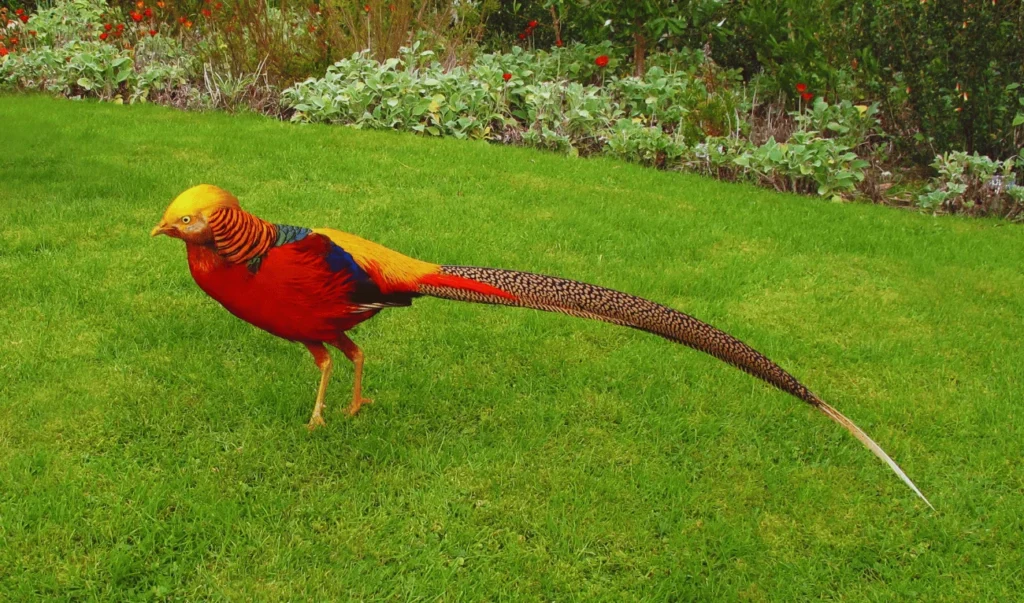
Despite being classified as “Least Concern” by the IUCN, Golden Pheasant populations are experiencing declining trends primarily due to habitat loss, overhunting, and capture for the pet trade.
Conservation efforts are crucial in preserving their remaining habitats and promoting sustainable management practices.
Threats
- Habitat Loss: The direct consequence of deforestation and logging activities that continue to encroach upon their natural habitats.
- Overhunting: Illegal poaching for food and the pet trade remains a significant threat to wild populations.
Conservation Efforts
- Habitat Protection: Critical initiatives aimed at preserving and restoring forested habitats essential for the species’ survival.
- Sustainable Practices: Advocacy for responsible land use practices and forestry management to mitigate the impact of habitat destruction.
Interesting and Lesser-Known Facts
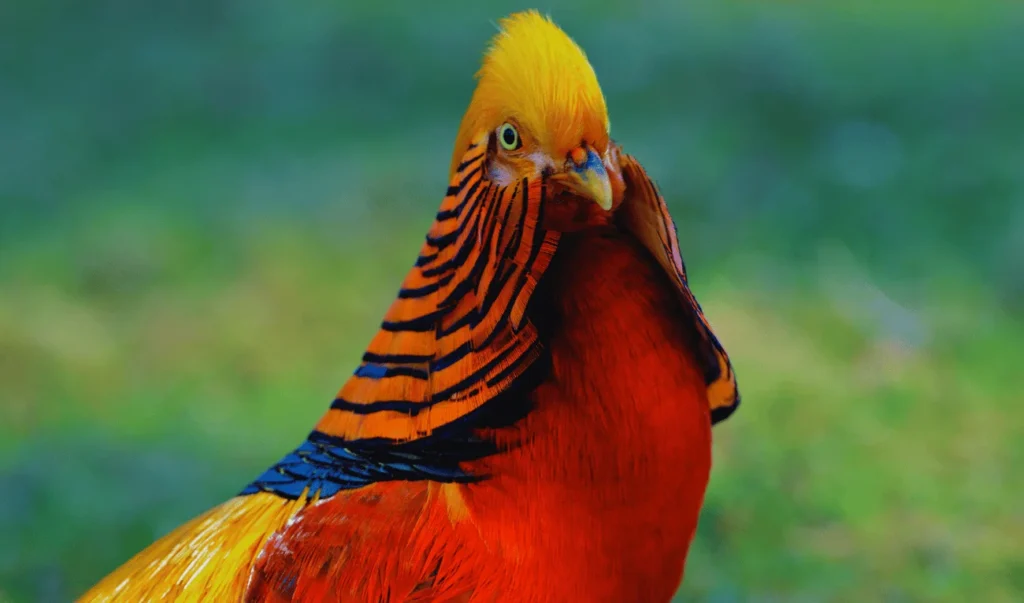
Delve into the fascinating aspects of the Golden Pheasant that highlight its uniqueness and ecological significance:
- Seasonal Plumage: Male Golden Pheasants undergo seasonal color changes, intensifying their plumage during the breeding season to attract potential mates.
- Polygamous Behavior: Males are polygamous, mating with multiple females during each breeding season to ensure genetic diversity.
- Rapid Growth: Chicks demonstrate rapid growth, achieving the ability to fly within just two weeks of hatching, a testament to their precocial nature.
- Crepuscular Activity: The species exhibits crepuscular behavior, meaning they are most active during the twilight hours of dawn and dusk, optimizing foraging while minimizing exposure to predators.
- Keen Senses: Enhanced hearing and sight capabilities aid in predator detection and locating food sources within their densely vegetated habitats.
- Silent Flight: Despite their vibrant plumage, Golden Pheasants are adept at flying silently, reducing their risk of detection by potential predators.
- Varied Vocalizations: Their repertoire of vocalizations includes whistles, clucks, and purrs, used for communication, mating calls, and territorial defense.
- Cultural Significance: In Chinese culture, the Golden Pheasant symbolizes nobility and prosperity, often depicted in traditional art and folklore.
- Dust Bathing: Routine dust baths are essential for maintaining plumage health and controlling parasites, demonstrating their adaptation to natural grooming behaviors.
- Design Inspiration: The striking colors and patterns of the Golden Pheasant’s plumage have influenced various artistic and fashion designs across cultures.
Best Places to Watch the Golden Pheasant
Golden Pheasants are best observed in their native habitats, where they blend harmoniously with the forest environment. Here are some recommended locations and tips for birdwatching enthusiasts:
1. Foping National Nature Reserve, China
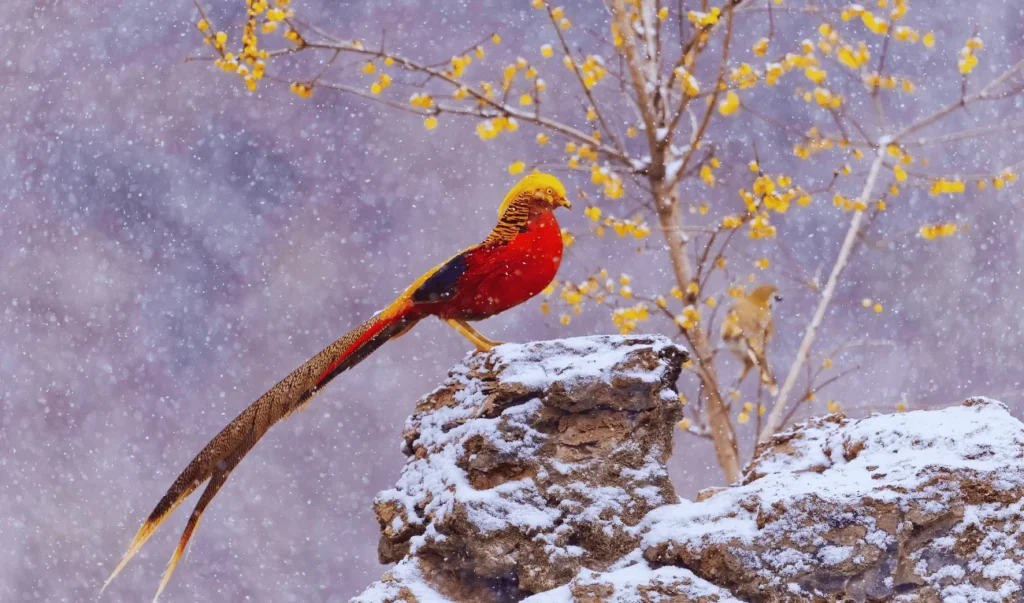
- Location: Located in the Qinling Mountains of Shaanxi province.
- Why Visit: Foping offers pristine forests and ample opportunities to observe Golden Pheasants in their natural habitat.
- Pro Tip: Early morning or late afternoon offers the best chances for sightings as the birds are most active during these times.
2. Wolong National Nature Reserve, China
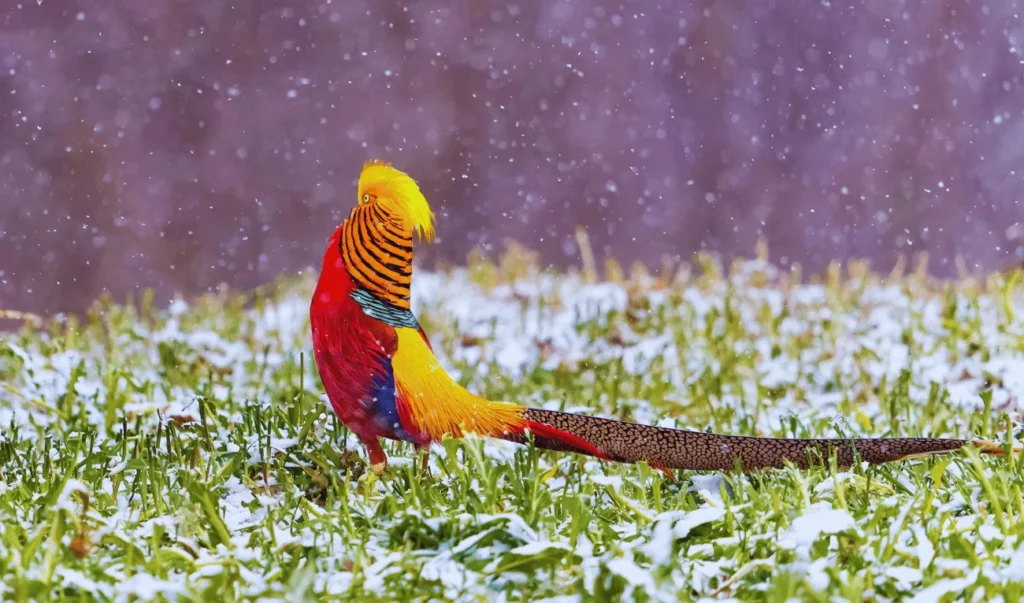
- Location: Situated in Sichuan province, known for its biodiversity and conservation efforts.
- Why Visit: Home to a variety of wildlife including pandas and Golden Pheasants, providing a unique birdwatching experience.
- Pro Tip: Engage local guides who are familiar with the area and can help navigate the reserve’s trails to increase your chances of spotting these elusive birds.
3. Peak District National Park, United Kingdom

- Location: Found in central England, featuring diverse landscapes including moorlands and woodlands.
- Why Visit: Houses several introduced populations of Golden Pheasants, offering opportunities for sightings outside their native range.
- Pro Tip: Early morning walks along woodland edges or near water sources can enhance your chances of encountering these colorful birds.
4. High Park, Toronto, Canada
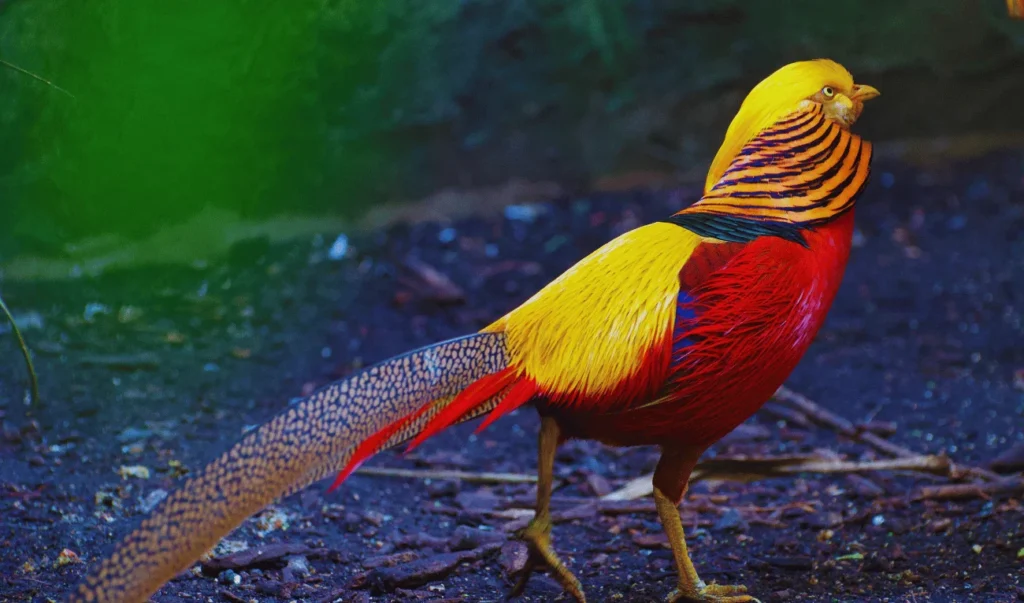
- Location: Located in Toronto, Ontario, Canada.
- Why Visit: High Park hosts a resident population of Golden Pheasants within its expansive green spaces, providing urban birdwatchers a chance to observe these birds up close.
- Pro Tip: Visit during quieter times such as weekdays or early mornings to avoid crowds and increase your chances of peaceful observation.
5. Bavarian Forest National Park, Germany
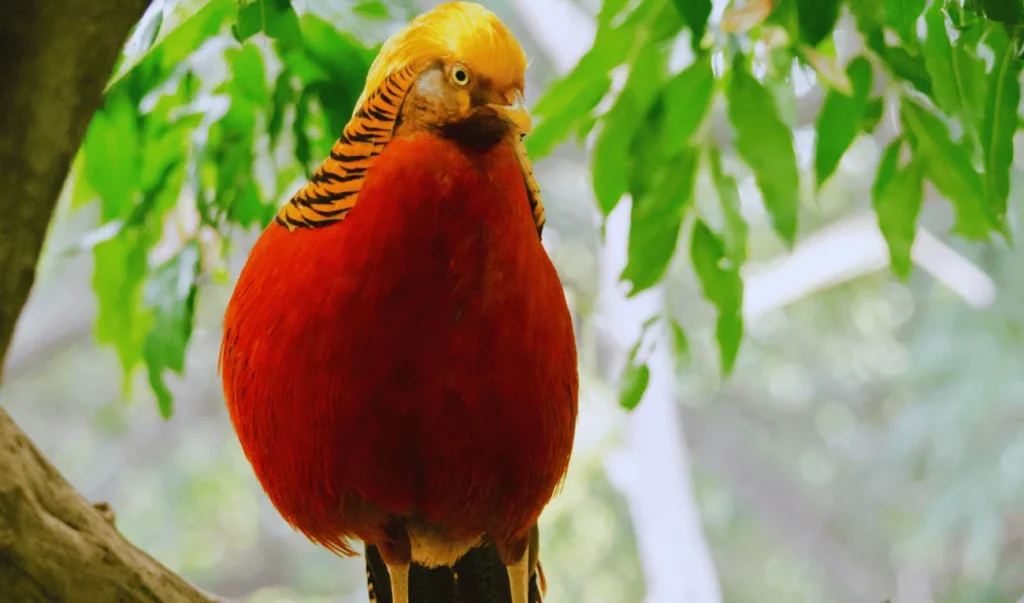
- Location: Situated along the border with the Czech Republic, renowned for its ancient woodlands.
- Why Visit: Offers glimpses into reintroduced populations of Golden Pheasants, supported by conservation efforts within the park.
- Pro Tip: Plan visits during the spring or early summer when bird activity, including courtship displays, is at its peak.
Pro Tips for WATCHING Golden Pheasants
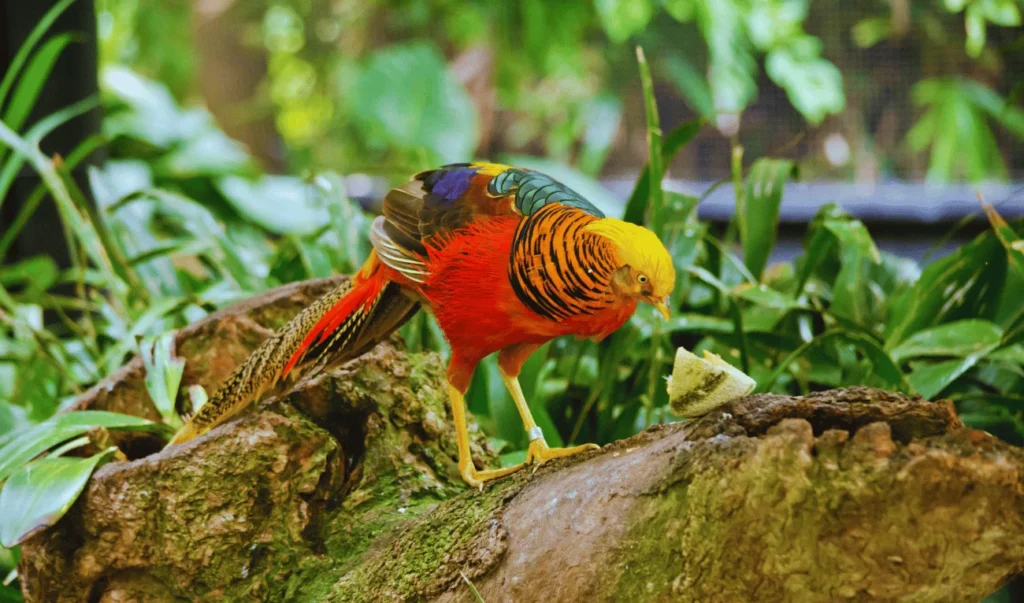
By following these pro tips, you can increase your likelihood of encountering and observing Golden Pheasants in their natural environment while contributing to their conservation and protection.
1. Choose the Right Time of Day
- Early Morning and Late Afternoon: Golden Pheasants are most active during these times, making them ideal for sightings.
2. Use Binoculars and a Telephoto Lens
- Enhanced Viewing: Binoculars and telephoto lenses allow for detailed observation while maintaining a respectful distance.
3. Learn Their Vocalizations
- Identify Calls: Familiarize yourself with Golden Pheasant vocalizations to detect their presence even when they are hidden.
4. Visit Protected Areas and Reserves
- Conservation Areas: National parks and wildlife reserves provide protected habitats where Golden Pheasants thrive.
5. Be Patient and Quiet
- Avoid Disturbance: Practice patience and silence to prevent startling Golden Pheasants and maximize observation time.
6. Study Their Behavior
- Habitat Preferences: Learn about their preferred habitats and feeding behaviors to locate them more effectively.
7. Respect Natural Boundaries
- Minimize Disturbance: Stay on designated paths and respect natural boundaries to minimize habitat disturbance.
8. Engage Local Guides
- Expert Insight: Seek guidance from local guides to gain valuable knowledge and enhance your birdwatching experience.
9. Dress Appropriately
- Camouflage Clothing: Wear muted, earth-tone clothing to blend into the surroundings and avoid alarming the birds.
10. Document Responsibly
- Ethical Photography: Use non-intrusive photography techniques to capture images while prioritizing the birds’ well-being.
Conclusion
The Golden Pheasant stands as a testament to the diversity and beauty of our natural world. By deepening our understanding of its ecological role and actively participating in conservation efforts, we can ensure that this magnificent species continues to thrive for future generations. Whether admired for its vibrant plumage or studied for its complex behaviors, the Golden Pheasant serves as a captivating reminder of the wonders of nature that deserve our protection and admiration.
